View in other NatureServe Network Field Guides
NatureServe
Montana
Utah
Wyoming
Idaho
Wisconsin
British Columbia
South Carolina
Yukon
California
New York
Brown's Microcylloepus Riffle Beetle - Microcylloepus browni
State Rank Reason (see State Rank above)
This riffle beetle is currently listed as "S1" in MT due to extremely limited and/or rapidly declining population numbers, range and/or habitat, making it highly vulnerable to global extinction or extirpation in the state. These warm-spring beetles are generally endemic to only a few locations; this species is endemic to 1 known location, a warm springs in the Bridger Creek Canyon outside of Bozeman.
General Description
[From Hatch 1938] "Length 2 mm.; piceous, the antennae, elytra, tibiae and tarsi paler; pronotum quadrate, about five-sixths as broad as long, sides bisinuate, anterior angles prominent and acute, posterior angles slightly acute; disc of pronotum uniformly alutaceous, set with fine hairs, with an elevated, slightly sinuate carina extending from base to apex on either side at a distance from either lateral margin of about one-fifth the total width of the pronotum; the surface of the pronotum undulating with an especialy prominent longitudinally oval impresssion on the middle line just in front of the middle and other less prominent impressions at about the anterior third along the lateral marginsand at about basal third just within the lateral carinae and elsewhere; elytra uniformly smooth, shining, set with fine hairs and with about ten longitudinal series of punctures the outer two of which are invisible in dorsal view, the second interval carinate in basal fourth, the fifth interval carinate in about basal three fifths, the seventh interval strongly carinate nearly to apex."
Phenology
Adults presumably active throughout the year.
Diagnostic Characteristics
Determined by a combination of the sculpture of the pronotum (neither smooth nor with a transverse impression between the lateral carinae) and the pronotum shape (quadrate, 5/6 as long as broad) (Hatch 1938).
Species Range
Montana Range
Range Descriptions
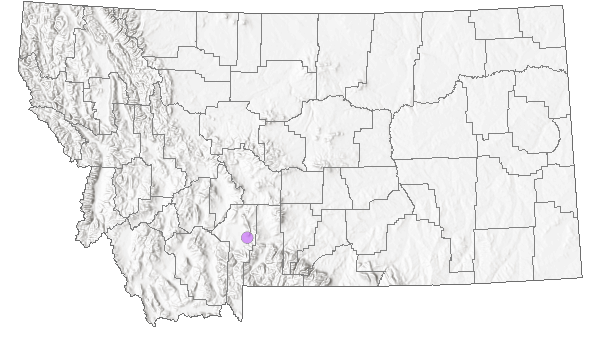
 Native
Native
Range Comments
Montana endemic: limited to 4 warm water seep areas downstream of Bridger Canyon Warm Springs (Kindschi 1994). Rangewide, inhabits four warm water seeps that surface and flow into Bridger Creek along Fish Hatchery Road near Bozeman, Gallatin County, at about 1518 m elevation. The occupied area, approximately 35 square meters, is owned by the federal government and lies on the Fish Technology Center property. It is assumed that M. browni is endemic to warm water seeps 250-400 m downstream from where Z. thermae is found (Hooten 1991). Z. thermae has the same known site, except they are further limited to the upstream section of the warm spring.
Observations in Montana Natural Heritage Program Database
Number of Observations: 3
(Click on the following maps and charts to see full sized version)
Map Help and Descriptions
Relative Density
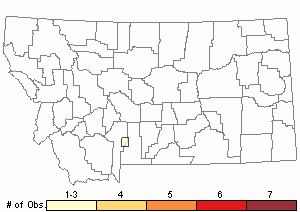
Recency
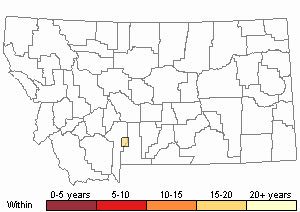

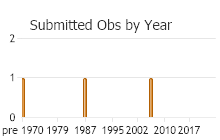
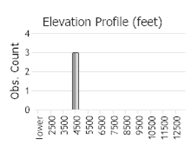 (Observations spanning multiple months or years are excluded from time charts)
(Observations spanning multiple months or years are excluded from time charts)
Migration
Restricted to warm springs, adults are flightless and not known to migrate between sites.
Habitat
Requires surface flowing warm water with temperatures between 60-84 deg. F; found frequently in muddy areas containing watercress and less of a rocky substrate (Kindschi 1994). These beetles feed on small pieces of algae and diatoms that they scrape from submerged rocks on the gravel bottom and among vegetation. Both Z. thermae and M. browni require warm and flowing surface water with temperatures of 60 to 84° F. They are endemic to Bridger Creek Warm Springs near Bozeman, MT.
Food Habits
Uses mandibles for feeding on small pieces of algae and diatoms, scraping the food from rocks (Kindschi 1994).
Ecology
Adults are probably long-lived (>1 year); they are restricted in their dispersal capabilities by flightlessness and also by their requirement for thermal water (Brown 1976); it is likely, however, that mature larvae crawl out of the warm spring and pupate near its edge (Hooten 1991).
Reproductive Characteristics
Little is known of the reproduction habits of these beetles, but sexual reproduction of the adults likely occurs on cobbles during winter low water flow periods, and the females will lay eggs on these cobbles or adjacent vegetation.
Management
Microcylloepus browni is a Montana Species of Concern because they are extremely locally distributed riffle beetles (1 known spring site). They occupy limited spring or seepage habitat (total area=35 m2) in and along Bridger Creek where it flows through the property of the U.S. Fish and Wildlife Service’s Bozeman Fish Technology Center (Technology Center) at the mouth of Bridger Canyon, Montana. The globally rare (G1) rankings are largely due to the single locality that this species is found.
Stewardship Responsibility
Threats or Limiting Factors
Restricted habitat, future human development upstream in the watershed could affect surface flows of this spring (Kindschi 1994). (Kindschi 1994). Specific threats to populations of Z. thermae and M. browni include habitat alteration from the development of warm water and surface water from Bridger Creek which may have adversely affected habitat; although specific impacts are not documented since water use began more than 100 years ago. Upstream land use activities have potential to become a threat but are not known to be a problem at this time aside from some detectable sedimentation.
References
- Literature Cited AboveLegend:
 View Online Publication
View Online Publication Brown, H. P. 1976. Aquatic Dryopoid beetles (Coleoptera) of the United States. U.S. Environmental Protection Agency, Office of Research and Development, Environmental Monitoring and Support Laboratory, Cincinnati, OH. E.P.A. Document # 600/B-76-001.
Brown, H. P. 1976. Aquatic Dryopoid beetles (Coleoptera) of the United States. U.S. Environmental Protection Agency, Office of Research and Development, Environmental Monitoring and Support Laboratory, Cincinnati, OH. E.P.A. Document # 600/B-76-001. Kindschi, G. 1994. Memorandum: Draft beetle conservation management plan and update on recent activities. FWS Fish Technology Center, Bozeman, Montana. 10 pp plus tables.
Kindschi, G. 1994. Memorandum: Draft beetle conservation management plan and update on recent activities. FWS Fish Technology Center, Bozeman, Montana. 10 pp plus tables.
- Additional ReferencesLegend:
 View Online Publication
View Online Publication
Do you know of a citation we're missing? Hatch, M. H. 1938. Description of two new riffle beetles. Entomological News 49:16-19.
Hatch, M. H. 1938. Description of two new riffle beetles. Entomological News 49:16-19. Krise, William, Mark Wilson, Chris Hunter and Daniel Gustafson. 2006. Conservation agreement and strategy for Thermae Riffle Beetle (Zaitzeva thermae) and Brown's Riffle Beetle (Microcylloepus browni) at the Bozeman Fish Technology Center, Bozeman, Montana.
Krise, William, Mark Wilson, Chris Hunter and Daniel Gustafson. 2006. Conservation agreement and strategy for Thermae Riffle Beetle (Zaitzeva thermae) and Brown's Riffle Beetle (Microcylloepus browni) at the Bozeman Fish Technology Center, Bozeman, Montana.
- Web Search Engines for Articles on "Brown's Microcylloepus Riffle Beetle"
- Additional Sources of Information Related to "Insects"





